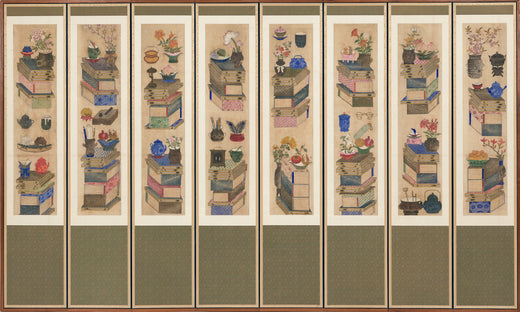FREE Shipping on all product orders over $75! Promo Code: FREESHIP Shop Now

| # | Contents |
|---|---|
| Title | Books and Scholars' Accoutrements |
| Creator | Unidentified Korean artist |
| Format | Eight-panel folding screen |
| Type | Painting and Drawings |
| Medium | Ink and color on silk |
| Description | Stylized depictions of books, writing utensils, ancient bronzes and ceramics, flower and fruit arrangements, and several other items associated with the noble Confucian scholar are arrayed among the eight individual, vertically oriented paintings that comprise this tall folding screen. Each panel of the screen contains a composition of two slightly angled stacks of Chinese-style bound books surrounded by a variety of scholarly paraphernalia, including antique vessels, spectacles with an accompanying case, and so-called “Four Friends of the Scholar – a calligraphy brush, ink stick, inkstone, and rolls of paper. Painted in ink and bright colors on a plain, colorless silk ground, some objects appear to be floating in space, whereas others appear to rest atop the stacks of books, which provide the overall composition some semblance of three-dimensional space. A well-known Confucian subject known in Korean as Ch’aekkŏri, or “books and things,” such paintings are still-life compositions of items with which the ideal Confucian scholar surrounded himself in his studio. Although the subject originated in China, by the late eighteenth century the royal court in Korea began to commission Ch’aekkŏri paintings to display behind desks in men’s quarters. In the nineteenth century such paintings became widely popular decorative items among the gentry class, for these paintings conveyed an air of dignity, luxury, and reverence for scholarship. They were also used in the households of commoners who appreciated, but usually could not afford, the luxury goods illustrated in the paintings. The essential elements of any Ch’aekkŏri painting are the scholar’s items, but as the theme became popularized, fruits, flowers, and other objects symbolic of prosperity, fecundity, and longevity made their way into the compositions. Ch’aekkŏri thus also functioned as talismans, since they promoted virtue and harmony in the household, just as the practice of Confucian moral conduct by persons of all classes was believed to ensure harmony in the state. |
| Rights | Harvard University Art Museums |
| Accession Number |
2014.198 |
| Period | Joseon Dynasty (1392-1910) |
| Culture | Korean |
| Geographic Origin | Korea |
| Dimensions |
each painting: H. 121.5 x W. 27.8 cm (47 13/16 x 10 15/16 in.) |
| Resource URL |


